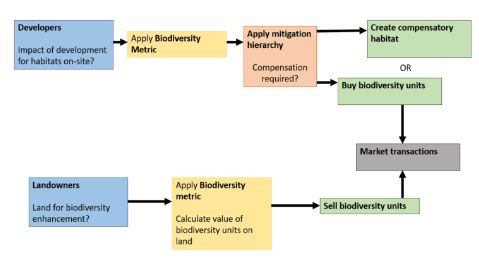Compensating biodiversity losses off-site: what do we know so far?
Mateo Lewis
Compensating biodiversity losses off-site: what do we know so far?
By November 2023, obligations for developers, councils and communities to consider biodiversity net gain (BNG) for planning proposals are expected to come into effect. In a previous blog psot we summarise BNG and gave a brief overview of how it works in practice (you can read all about it here). To recap, BNG is seen as a method for ensuring that development projects contribute to the restoration of our ecosystems. By valuing existing habitats and modelling the impact a development will have on them (using tools such as Natural England's Biodiveristy Metric), developers can visualise how and where biodiversity gains can occur on a planned development. However, if habitat cannot be protected, enhanced or created on the site of a development, there remain options to create compensatory habitat off-site. But what do we know exactly about off-site biodiversity net gain delivery?
A first thing to note is that the technical aspects of off-site biodiversity net gain are still under review, with DEFRA holding a consultation in early 2022, the results are due to be published later this year. However, there are several features of off-site compensation that we know for certain.
The mitigation hierarchy: Compensation is a last resort
When approaching BNG for on-site gains, developers must apply the mitigation hierarchy to decide how to manage habitat losses. First, existing habitat should be retained and protected. Where this is not possible, enhancement of existing habitat can be considered, with the creation of new habitat third in this list of priorities. Creating off-site compensatory habitat can only be done if options for on-site habitat gain are not possible. When considering where compensatory gains can be provided, a spatial hierarchy must be applied, with local off-site delivery should be considered before off-site options are made further afield. The mitigation and spatial hierarchies are integrated into the Biodiversity Metric 3.0 (Natural England's tool for calculating habitats' value), as more biodiversity units are assigned to habitat within closer proximity to a development site.
Rules for off-site gain
Simply put, the same rules apply for off-site BNG as with on-site habitats. Off-site habitat must be valued using a calculation tool. In addition, the type of habitat created off-site has to be at least like-for-like when compared to the habitat being lost – or of a superior quality, distinctiveness or condition. Created habitat will have to be maintained for at least 30 years, with its protection secured through a planning obligation or conservation covenant. Current proposals dictate that compensatory habitat creation must commence within 12 months of a development being accepted. Finally, any newly created habitat will require a management and monitoring plan.
The market for biodiversity units
Under current proposals landowners will be able to create or enhance habitat for biodiversity and ‘sell' the unit worth of this habitat to developers seeking to compensate habitat loss. A 2021 Market Analysis Study estimated the cost of individual biodiversity units at £20,000. For sites already being used for biodiversity units, a register will be created linking the site to its development. The exact ins and outs of the biodiversity unit market are yet to be finalised.

Steps to consider for landowners and developers when interacting with BNG. Figure adapted from DEFRA.
As a last resort, developers will be able to buy Statutory Biodiversity Credits from the government in case the market fails to provide suitable options, and if developers can prove that net gain on site is possible. The revenue from credit sales generated by the government will be re-invested back into strategic biodiversity enhancement. The effectiveness of the government's policy to step in as a ‘seller of last resort' has been questioned, however.
Summary
- Off-site BNG delivery can only be considered for a development after other appropriate options within the mitigation and spatial hierarchies are deemed unsuitable
- A legal framework exists to ensure that off-site BNG is of a good quality, is protected and is managed over a substantial time period
- A biodiversity unit market will give developers the opportunity to buy biodiversity units from landowners. The technicalities of this mechanism are still to be finalised, and it is uncertain to what extent the government will be able to act as a backup provider of credits in case the market fails
It's clear that key information concerning the delivery of compensatory BNG delivery remains unpublished. We are still waiting on the findings of a DEFRA consultation held on this topic which closed in April. DEFRA also need to show that the proposed biodiversity unit market is robust and that an adequate supply of habitat can be provided.
Keen to stay in the loop? We'll share updates on new guidance for BNG as and when it is published!
Sources:
Biodiversity Net Gain: Market Analysis Study. 2021. Report for DEFRA prepared by the Economics for the Environment Consultancy
